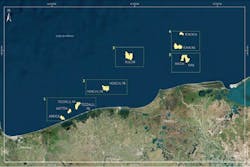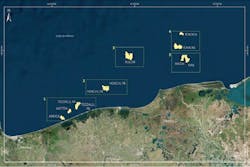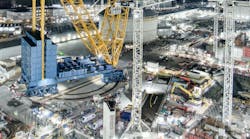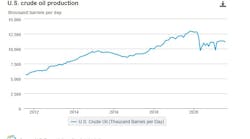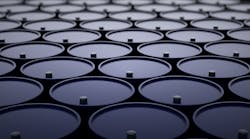Oil and gas companies head into 2018 in their best financial shape since oil prices started falling, claims consultant Wood Mackenzie in its 2018 Upstream Outlook.
Senior vice president Tom Ellacott said: “Now that the belt-tightening is done, companies are looking to deliver profitable growth and build for the future. We also expect to see signs that the investment cycle is starting to turn and the sector has reset itself to operate at lower commodity prices.”
Angus Rodger, upstream research director, added: “The downturn meant that close to $1 trillion was taken out of company spending from 2015 to 2020. But we believe the big cuts are over. Wood Mackenzie expects global capital expenditure to grow slightly in 2018 to a total of $400 billion.”
LNG spending is set to fall by around 40% next year to $16 billion, as big projects are completed in Australia and Russia, but spending on deepwater projects is set to rise by 15%, following a three-year decline in this sector.
Wood Mackenzie also anticipates a third successive increase in project sanctions following the low of 2015, up from just over 20 in 2017 to 25 in 2018. This is in part due to operators looking to take advantage of locking into current low equipment/service costs.
“The rise in project sanctions will be a clear sign that new projects can work in a low-price environment,” said Ellacott. “Oil and gas companies will continue to adapt portfolios to perform at high and low prices and also to provide a platform for longer-term energy transition.”
Ellacot observed that: “Optimizing the core business, controlling costs, and employing digital technology like predictive analytics will all play a part. We expect companies to continue to develop high-value, low-cost oil. Building exposure to gas will also be a core strategic objective for most larger companies as they transition towards low-carbon portfolios.”
Wood Mackenzie expects Iran and the United Arab Emirates to award at least 10 Bboe of discovered resources for development next year, with growing interest also in Latin America. In Brazil, around 10 Bboe of deepwater resources could be auctioned in 2018.
“Looking at the upstream sector as a whole, we expect more activity from the Asian NOCs as they tackle structural production declines,” Ellacot commented. “The majors will continue to cherry-pick opportunities, building on the great progress already made in repositioning portfolios for lower prices.”
EIA issues 2018 forecast
The US Energy Information Administration issued its short-term energy outlook in December, including projections for crude oil prices and supply in 2018. Some of the more notable findings included:
• North Sea Brent crude oil spot prices averaged $63/bbl in November, an increase of $5/bbl from the average in October. EIA forecasts Brent spot prices to average $57/bbl in 2018, up from an average of $54/blb in 2017.
• West Texas Intermediate (WTI) crude oil prices are forecast to average $4/bbl lower than Brent prices in 2018. After averaging $2/bbl lower than Brent prices through the first eight months of 2017, WTI prices averaged $6/bbl lower than Brent prices from September through November.
• NYMEX WTI contract values for March 2018 delivery traded during the five-day period ending Dec. 7, 2017, suggest that a range of $48/bbl to $68/bbl encompasses the market expectation for March WTI prices at the 95% confidence level.
• EIA estimates that US crude oil production averaged 9.7 MMb/d in November, up 360,000 b/d from the October level. Most of the increase was in the Gulf of Mexico, where production was 290,000 b/d higher than in October. Higher production in November reflected oil production platforms returning to operation after being shut in response to Hurricane Nate. EIA forecasts total US crude oil production to average 9.2 MMb/d for all of 2017 and 10.0 MMb/d in 2018, which would mark the highest annual average production, surpassing the previous record of 9.6 MMb/d set in 1970.
Eni has increased the in-place estimate for Area 1 offshore Mexico, following the results of the Tecoalli 2 well and the revision of the reservoir models of the Amoca and Miztón fields. (Courtesy CNH)
Eni concludes drilling campaign in Area 1 offshore Mexico
Eni has increased the in-place estimate for Area 1 offshore Mexico from 1.4 to 2.0 Bboe, of which about 90% being oil and the remaining associated gas.
This follows the results of the Tecoalli 2 well and the revision of the reservoir models of the Amoca and Miztón fields.
The Tecoalli 2 well, located in Contractual Area 1 in the Campeche Bay, is about 200 km (124 mi) west of Ciudad del Carmen, in 33 m (108 ft) of water depth.
The well reached a final depth of 4,420 m (14,501 ft) encountering approximately 40 m (131 ft) of net oil pay in the Orca formation, characterized by excellent quality sandstone reservoirs. The well was then deepened to the Cinco Presidentes formation exploratory target, finding further 27 m (89 ft) of net oil pay.
A production test will now be executed and then the well will be temporarily abandoned. The Tecoalli field is 24 km (15 mi) from the Amoca field and 13 km (8.1 mi) from the Miztón field.
Eni will soon submit the development plan (PoD) for Area 1 to the approval of the local authorities (Comisión Nacional de Hidrocarburos). As soon as the PoD is approved, Eni will sanction the development (FID), with production startup planned in first half 2019.
Repsol plans six more wells, WAG injection for Yme redevelopment offshore Norway
Repsol has submitted a new plan for development and operation (PDO) for the Yme field in the Norwegian North Sea, with an estimated cost of more than NOK8 billion ($953 million). Start-up is slated for 2020.
The company plans to use existing facilities that were installed on the field during an earlier development phase in 2007, with oil produced through the leased jackup drilling and production facility, Mærsk Inspirer, which will be modified and adapted to operate on Yme.
The Norwegian Petroleum Directorate (NPD) assesses the field’s future recoverable oil resources at 65 MMbbl.
Over the next few weeks, the NPD will review the proposals and assess the associated financial, technical, and resource-related risks.
